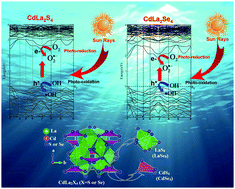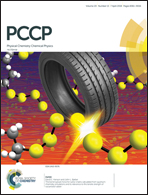Novel photocatalytic water splitting solar-to-hydrogen energy conversion: CdLa2S4 and CdLa2Se4 ternary semiconductor compounds
Abstract
Comprehensive ab initio calculations from first- to second-principles methods are performed to investigate the suitability of non-centro-symmetric CdLa2S4 and CdLa2Se4 to be used as active photocatalysts under visible light illumination. The calculations reveal the direct band gap nature of both compounds with large absorption coefficients (104–105 cm−1). The absorption edges of CdLa2S4 and CdLa2Se4 occur at λ = 579.3 nm and λ = 670.1 nm, and the optical band gaps are estimated to be 2.14 eV and 1.85 eV for CdLa2S4 and CdLa2Se4, respectively. These gaps are larger than 1.23 eV the required optical band gap for photocatalytic performance to split water under visible light illumination. The calculated potentials of the conduction band and the valence band edges indicate that CdLa2S4 and CdLa2Se4 have strong reducing powers for H2 production. The obtained results reveal that the high photogenerated carrier mobility favors enhancement of the photocatalytic performance. It has been found that there is a large mobility difference between the electrons (e−) and the holes (h+), which is useful for the separation of e− and h+, reduction of e− and h+ recombination rate, and improvement of the photocatalytic activity. Based on these findings, one can conclude that CdLa2S4 and CdLa2Se4 satisfied all requirements to be efficient photocatalysts. This will greatly improve the search efficiency and greatly help experiments to save resources in the exploration of new photocatalysts with good photocatalytic performances.



 Please wait while we load your content...
Please wait while we load your content...